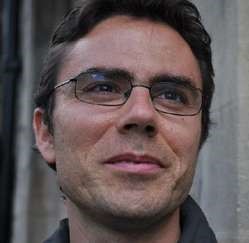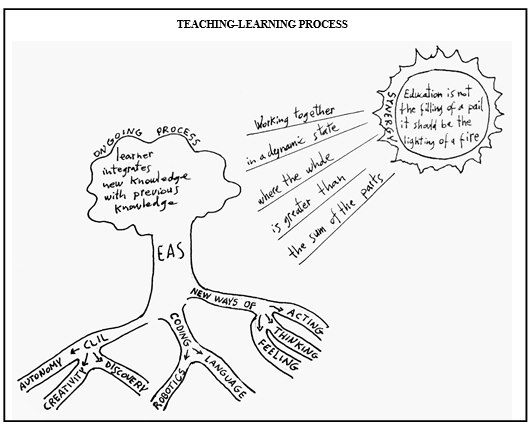EAS and CLIL for Innovating
Gianluigi Basile is a primary school teacher at IC Franco Marro Villar Perosa. He is interested in the CLIL approach, EAS method and new technologies. He has written a unit plan for the Italian magazine “Essere A Scuola”. Current professional interests are in changing our role as teachers. He also enjoys working with other schools within European projects. Email: indirizzoelettronico@yahoo.it


Our role as teachers
We as teachers have to deal with the teaching/learning process which is, without a doubt, a very complex phenomena.
However, complex does not mean complicated. We are not facing a confused and tangled skein of thread but rather to a phenomena featured by multiple elements which interact with each other and which assume features which do not come from the sum of each part.
I have tried to visualise those elements with a picture which gives the sense of movement, therefore of the flexibility, as well as of the solidity at the same time. Starting from the sun, paraphrasing the poet W.B. Yeats, the educational action must activate that fire which fosters this process, rather than fill the heads of our pupils. The energy-synergy (solar crown) activated, is radiating and works putting into place the collaboration-cooperation among the variety of elements which play a role (sunbeams) to make the potential of each one grow. The tree foliage grows, and is shaping; it is the process in continuously integrating the new knowledge with the previous ones.
EAS method - What is it?
For this reason I consider the EAS (Episodio di Apprendimento Situato. in English it corresponds with “episode of situated learning”) method very interesting since it puts together the variety of aspects involved.
This method offers a way to plan our lesson taking into account all of the important aspects which will be essential for a good outcome of action. It has been thought by the professor Pier Cesare Rivoltella (Università Cattolica di Milano-Italy) and it is based on the ideas of the flipped lessons and the micro-learning.
In the following I symbolized that method with the tough trunk and it organises the teacher’s action without bridling it but giving a safe framework as a landmark with its three stages:
- preparatory phase;
- operating phase;
- restructuring phase.
Coming to the roots, in the picture, they draw from many resources. Among them I wanted to show the necessity of considering “new ways of acting, thinking, feeling”. I think that our society is distinguished by ongoing changes and the school needs to be aware about that and it must deeply rethink about itself. In this view I consider really efficient the framework proposed by the EAS method which implicates a deep reconsideration of the teacher’s role: “The teacher is present in redirecting the access phase to the information, in the organisation and in monitoring of the work stages, in the lesson in retrospect.” (Rivoltella, 2016: 29). It is with no doubt the consideration that nowadays the access to the knowledge is something that more and more lies outside from the circumscribed school environment.
In this regard, Fiorin's observation (2013: 31) is simple and clear: "The teacher must gain an authority that no longer derives from the wealth of knowledge accumulated in the past available to him, but from his ability to provide the essential equipment to face the incognito ". This is why even the new technologies in the school assume a strategic importance to ensure that pupils learn to use them to their advantage as tools that contribute to the achievement of key competences. More specifically, I think “coding” is an opportunity to work with problem solving elements and the laboratory dimension that characterize both EAS and CLIL and therefore robotics that offers integration with another programming language.
The wider use of digital devices is also a great opportunity to reassess and enhance manual skills in the perspective of laboratory activities based on task-based methodologies, which become strongly enhanced by the use of digital technologies to document, display and share the work done. The aspect of manual skills is enhanced by well-known exponents of the world of education, but I would like to quote a testimony which I came across by chance, contained in an interview by Primo Levi and Tullio Regge: "The hand is a noble organ, but school, all taken up with the brain, had neglected it. And besides, the laboratory was collegial, a centre of socialization where one really made friends. As a matter of fact, I remain friends with all my laboratory colleagues. It was the team work, which in the preceding school was unknown [...]” (Levi and Regge, 1989: 19).
CLIL approach
The challenge that we face is therefore the increasing importance of involving students in the construction of their knowledge. In this regard, I believe that CLIL "Content and Language Integrated Learning" plays a fundamental role: "CLIL teachers will have to consider how to actively involve students and learn how to implement them" (Coyle, Hood and Marsh, 2010: 29).
This approach offers the way to make children work on new subject contents using a foreign language and enhancing both of them (content and language). The key word is: "integrate", and for this the CLIL approach, which develops in the child: autonomy, creativity, discovery, is very significant for me. Here "integration" has a fundamental role between content and language, but more broadly between different synergies: "All learning is complex, and understanding the potential of integrating content and language demands and an exploration of synergies" (Coyle, Hood and Marsh, 2010: 27). Also Diana Hicks (2011) highlights how the success of the CLIL approach takes place when first of all the previous experiences, skills, interests and approaches that each child brings to the classroom are recognized and integrated.
EAS and CLIL together
With this in mind, which favours the active role of children, the phases of the EAS method well match with the CLIL approach. In the first phase EAS (preparatory phase) the pupil is put in a position to use his knowledge and skills to face the requested task (as in the idea of the flipped classroom). At the same time, CLIL underlines the essential importance of activating "thinking skills" of children in the first minutes. Diana Hicks (2011) points out that the first five to ten minutes of the lesson are essential for how the follow-up of the activity will develop. Moreover, at this stage she talks about "slow thinking time" to allow each child to be able to give his/her own cognitive contribution with a pleasant task for himself and with the presence of the teacher for possible support.
The second phase (operating phase) of the EAS method is the one in which the laboratory logics, previously mentioned, aimed at creating an artefact are realised. While in the final part of the same phase great importance is given to the sharing with the rest of the class what has been learned. Even in the CLIL approach we find this accent: "[...] Clegg also remarked: talking about something which is learning is important, because it is when we express a new concept linguistically that we gradually develop it. The concept may be developed into our minds, but we will start to communicate it linguistically, we do not know how clearly-or unclearly-it is formed. (Clegg, 2002a). If we accept these principles, then CLIL teachers need to encourage oral interaction in their classrooms. This raises the issue, of course, of how to create the 'affective conditions'. " (quoted in Ball, 2015: 136)
To do all this, CLIL forces us to think: "a high-challenges, high support" classroom (Gilbbons, 2009 quoted in Ball, 2015: 4). Another strength of CLIL is to create the conditions because during the work it emerges the need for specific "chunks of language" (two or more words that form a specific meaning) unplanned but which the scaffolding strategies allow to face. I think this is a great opportunity to rethink our action: "a shift from teacher talk to student intervention" (Ball, 2015: 21). We must consider that the language is developed through two types of communication called BICS (Basic Interpersonal Communication Skills) and CALP (Cognitive Academic Language Proficiency.) Essential are also the multiple cognitive skills, divided into LOTS (Lower Order Thinking Skills) and HOTS (Higher Order Thinking Skills) and remember that these multiple aspects of the language must be made visible in the planning of the activity, precisely because of their importance.
Finally, we can find a strong affinity between the two models (EAS and CLIL) also in the third phase EAS (restructuring phase) in which in both cases there is a considerable emphasis on a last step through the meta-cognitive reflection process to correct any misconceptions and consolidate the learning (as in Célestin Freinet's subsequent lectures).
To sum up, on the balance of the vision conveyed by the considerations presented above, I would like to express the result of the fascinating "learning-teaching process" with what the orchestra director Johanna Knauf, who is very committed in music education, told me:
"The human person can flourish in all its beauty when it is foster to believe in itself and is free to express itself in communion with many others who give their best to create, in the end, a masterpiece".
References
Ball, P., Kelly, K., Clegg, J. (2015). Putting CLIL into Practice, Oxford: Oxford University Press
Coyle, D., Hood, P., & Marsh, D. (2010). Content and Language Integrated Learning. Cambridge: Cambridge University Press
Derosa, D. A. and Abruscato, J. (2015). Teaching children Science. USA: Pearson.
Fiorin, I., Castoldi, M., Previtali, D. (2013). Dalle Indicazioni al Curricolo scolastico, Brescia: Editrice La Scuola.
Hicks D. (2011). Some practical stategies for the primary CLIL classroom-putting the 'I' back into CLIL, [Online]. Available at: http://share.dschola.it/dd4pinerolo/polol2/ [Accessed 9 June 2015].
Ioannou-Georgiou & Pavlos Pavlou (Eds.). (2011). Guidelines for CLIL Implementation in Primary and Pre-Primary Education. Country of Research-Cyprus: Externally funded-project PROCLIL program.
Levi, P. and Regge, T. (1989). Conversations, London: I.B. Tauris & Co Ltd Publishers.
Rivoltella, P.C. (2016). Che cos'è un EAS – L'idea, il metodo, la didattica. Brescia: Editrice La Scuola.
Please check the 21st Century Thinking Skills course at Pilgrims website.
Please check the Methodology and Language for Primary course at Pilgrims website.
Please check the CLIL for Primary course at Pilgrims website.
Implementing 21st Century Skills in ELT: Learning and Innovation - the 4C’s
Hajnalka Fruttus, HungaryFoam Rubber Frames for Creativity: Discovering Our Deep Emotions
Carmen Marchante, SpainSeed Germination Project – Creative CLIL
Anastasia Bykova, RussiaA Virtual Tour to London
Francesca Biz, ItalyEAS and CLIL for Innovating
Gianluigi Basile, ItalyEmpowering HOTS in EFL Settings: A Lesson on Child Prostitution
Yomaira Angélica Herreño, Colombia;Jhonathan Alexander Huertas Torres, Colombia